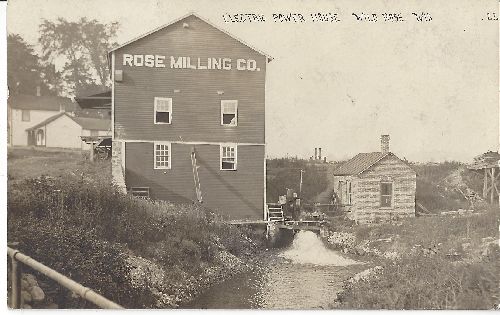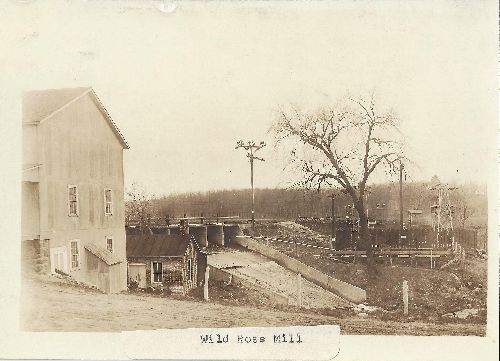About the Red Mill, formerly Ram Art Center and the Rose Milling Company


Village of Wild Rose Purchases Historic Wild Rose Mill as Part of Dam Reconstruction Project
The Village of Wild Rose has agreed to purchase the Red Mill from Amanda and Jerod Hoffman as part of its on-going project to replace the Mill Pond dam and revitalize its downtown.
“The economic impact of the Mill Pond and park has great value to all downtown businesses as the beauty of the Mill Pond is priceless,” stated John Eilers, Village President.
Village Trustee Jody Jansen worked with the Hoffmans on behalf of the Village Board to come to an agreement for the sale.
Trustee Jansen commented, “The Red Mill property that has been purchased, is an integral part of the dam.” He added, “The upcoming dam reconstruction would be much more difficult without the village owning that property.”
Over the last few years the Village of Wild Rose has worked on several projects to protect and enhance the natural beauty of its downtown and parks areas, from dredging the Mill Pond, to the larger project of building a boardwalk circling the Mill Pond connecting Roberts Park with North Park.
President Eilers went on to say, “This is the final step in securing the future of the Wild Rose Mill Pond and historic Red Mill.”
“After investing in dredging the Wild Rose millpond and the boardwalk around Roberts Park, plus the beautification of the park and millpond by the Wild Rose Area Improvement Association, the future of all projects is coming together,” he said.
To what use the mill will be put is still under discussion with many ideas on the table. From an historical aspect, much of the mill’s working structure is still in place. The purchase of the mill by the village will ensure the continued protection of this village landmark and a smooth process throughout the dam reconstruction.
Amid growing concerns regarding failures of dams across the state, many dams have been removed allowing waterways to resume their nature courses. Believing the Mill Pond to be a central feature of Wild Rose’s downtown and central to its continued economic vitality, the Village Board of Wild Rose has worked with the Department of Natural Resources (DNR) to develop a plan for the dam’s maintenance and repair.
Part of this plan has involved cleaning trees and brush from parts of the dam area considered the embankment. Although the embankment is an earthen work it provides some of the mass which creates the impoundment of the Pine River creating the Mill Pond. In addition to the physical structure most people understand to be a dam, Wisconsin law also considers these embankments, powerhouses, dikes, and canals to be part of the dam. In effect, the mill structure is part of the dam.
Two years ago the village first applied for a grant to cover part of the cost of the dam repair project. Although the grant request was rated a high priority on the first round of grant awards, it fell just below the cutoff for awards in that first grant award cycle. Upon reapplication, the village was awarded the grant.
“As we now have secured a dam grant paying fifty percent up to $400,000,” President John Eilers added, “the millpond and its beauty will be enjoyed by generations to come.”
Working estimate totals for the dam repair project are $313,700.
A major portion of the recent development of the Mill Pond and Roberts Park began under the leadership of James Erdman, former Village President, when an initial grant was awarded for the construction of the boardwalk circling the Mill Pond. A second smaller grant developed the trail connecting Roberts Park and North Park east of State Highway 22.
The Mill Pond is at the heart of activities in Wild Rose. Several businesses overlook the Mill Pond including the Wild Rose Hotel, Pumphouse on the Mill, and the Pioneer Pub. All of these are restaurants feature outdoor dining overlooking the Mill Pond’s natural beauty and stunning sunsets. The Mill Pond has also been the focus of the re-energized Wild Rose Days, now known as “Party on the Pond”. The last two years, organizers put on a firework display on Saturday night of the event over the Mill Pond. Roberts Park also has a ball diamond used for baseball and softball leagues and tournaments, a shelter house used by many residents for private events, picnic tables, fishing pier, and an outdoor basketball court.
Recently, Mary Kusche has spearheaded the beautification of the Mill Pond area by organizing the Friends of Roberts Park.
The mill is believed to have been built in 1873 and is a landmark in Waushara County. The mill is one of just three dozen existing inventoried properties in the village of Wild Rose listed in the Wisconsin Historical Society’s Wisconsin Architecture and History Inventory.
The mill and dam were first constructed by Francis A. Strong. The wooden water flume ran under the mill and originally drove two pen stocks each housing a water turbine. These turbines powered two mill stones; one for the grinding of flour, the other for the grinding of feed for livestock.
In 1904, the mill and dam were enlarged and modernized. Steel and concrete were used in this version of the dam. In 1908. the dam began generating electricity. From 1925, when Wisconsin Power and Light Company purchased the property until 1933, the dam generated enough power from water to electrify the entire village of Wild Rose.
The mill continued to operate as the Rose Milling Co. during this time and into the late 1960s under the ownership of Rodney Murty. During the 1970s the mill was briefly operated as the Ram Art Center. Since then it has been a private residence.
For much of the early 1900s, the Rail Road Commission and then the Public Service Commission (PSC) had jurisdiction over dams. In 1967, the Department of Natural Resources (DNR) was created, and jurisdiction over dams was handed over from the Public Service Commission (PSC) to the DNR. In the early 1980s, the DNR developed standards for design, construction and reconstruction of large dams, enacted Warning Sign and Portages for Dams rules for public safety. In 1991, procedures for implementation of dam maintenance, repair, modification or abandonment grant program were put into place.